Strategic Planning Report: Vista Group Strategic Analysis & Options
VerifiedAdded on 2023/01/12
|12
|3513
|2
Report
AI Summary
This report provides a strategic analysis of the Vista Group, a technology solutions provider in the global film industry. It begins by defining key strategic planning concepts such as vision, mission, strategy, and business plans, and explains their interrelationships. The report then explores how external factors, including political, economic, social, and technological influences, affect organizational strategy and the importance of environmental scanning. It evaluates the impact of stakeholder expectations on organizations. The core of the report analyzes Vista Group's mission and vision statements, assessing their influence on the company's strategy and how external influences shape strategic decisions. Strategic options for Vista Group are presented using the Ansoff Matrix, including market penetration, market development, product development, and diversification, with a detailed evaluation of each option. The report also discusses criteria for reviewing strategy options, such as sensitivity analysis and feasibility studies, and applies these criteria to evaluate potential strategic directions. Finally, the report outlines the structure of a plan needed to deliver the chosen strategy, including objectives, the STP model (segmentation, targeting, positioning), and budget formulation, along with stakeholder involvement and monitoring systems for successful implementation.
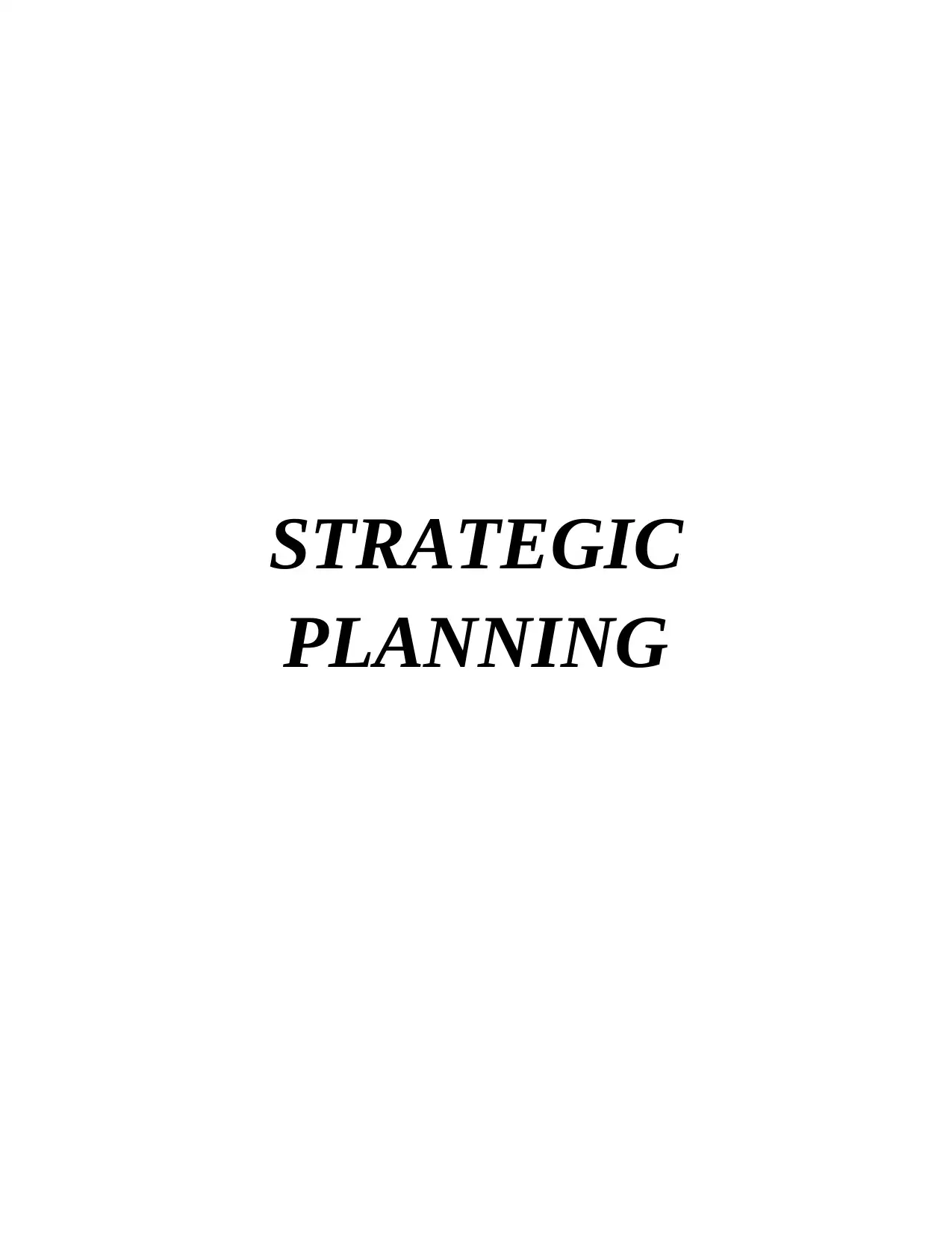
STRATEGIC
PLANNING
PLANNING
Paraphrase This Document
Need a fresh take? Get an instant paraphrase of this document with our AI Paraphraser
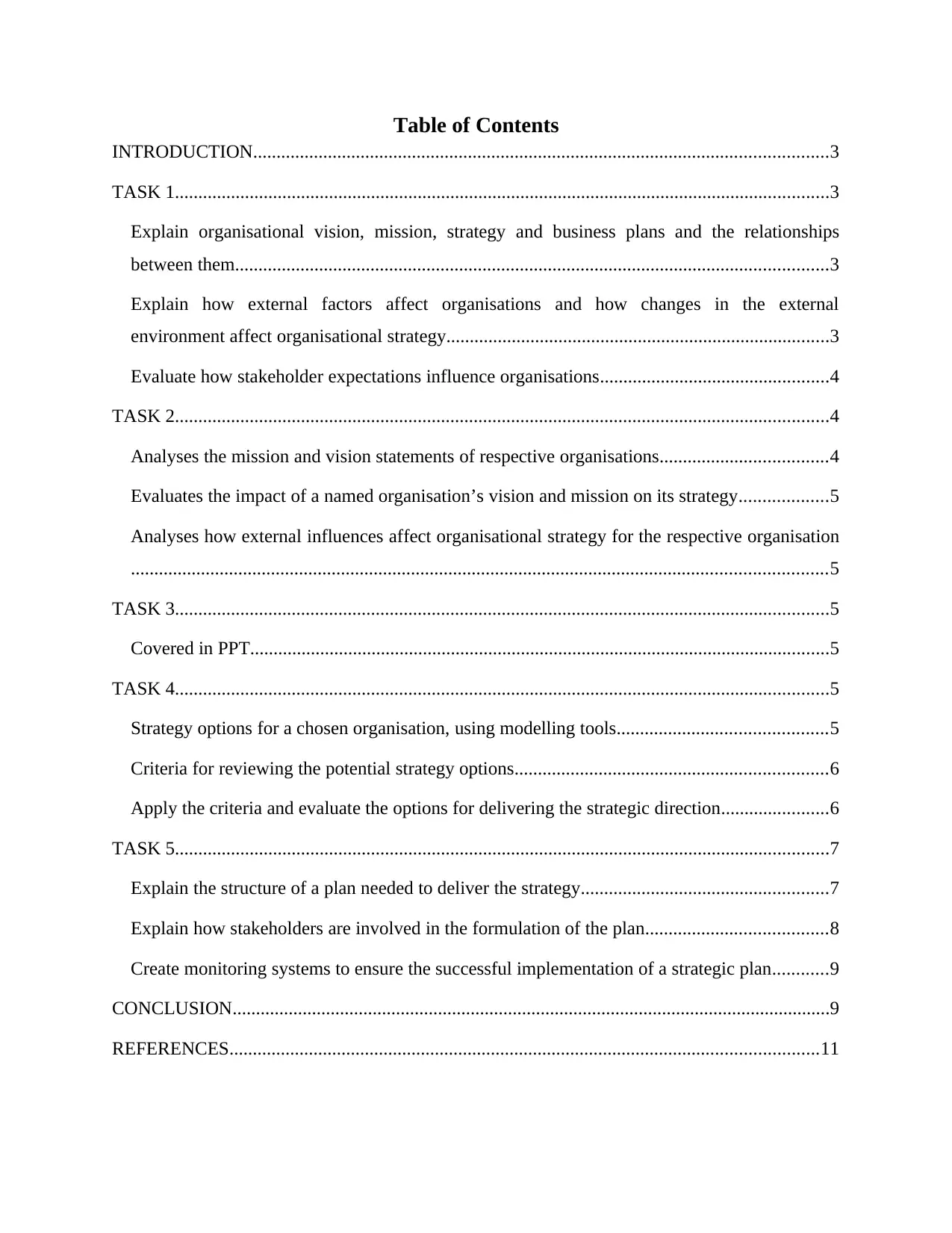
Table of Contents
INTRODUCTION...........................................................................................................................3
TASK 1............................................................................................................................................3
Explain organisational vision, mission, strategy and business plans and the relationships
between them...............................................................................................................................3
Explain how external factors affect organisations and how changes in the external
environment affect organisational strategy..................................................................................3
Evaluate how stakeholder expectations influence organisations.................................................4
TASK 2............................................................................................................................................4
Analyses the mission and vision statements of respective organisations....................................4
Evaluates the impact of a named organisation’s vision and mission on its strategy...................5
Analyses how external influences affect organisational strategy for the respective organisation
.....................................................................................................................................................5
TASK 3............................................................................................................................................5
Covered in PPT............................................................................................................................5
TASK 4............................................................................................................................................5
Strategy options for a chosen organisation, using modelling tools.............................................5
Criteria for reviewing the potential strategy options...................................................................6
Apply the criteria and evaluate the options for delivering the strategic direction.......................6
TASK 5............................................................................................................................................7
Explain the structure of a plan needed to deliver the strategy.....................................................7
Explain how stakeholders are involved in the formulation of the plan.......................................8
Create monitoring systems to ensure the successful implementation of a strategic plan............9
CONCLUSION................................................................................................................................9
REFERENCES..............................................................................................................................11
INTRODUCTION...........................................................................................................................3
TASK 1............................................................................................................................................3
Explain organisational vision, mission, strategy and business plans and the relationships
between them...............................................................................................................................3
Explain how external factors affect organisations and how changes in the external
environment affect organisational strategy..................................................................................3
Evaluate how stakeholder expectations influence organisations.................................................4
TASK 2............................................................................................................................................4
Analyses the mission and vision statements of respective organisations....................................4
Evaluates the impact of a named organisation’s vision and mission on its strategy...................5
Analyses how external influences affect organisational strategy for the respective organisation
.....................................................................................................................................................5
TASK 3............................................................................................................................................5
Covered in PPT............................................................................................................................5
TASK 4............................................................................................................................................5
Strategy options for a chosen organisation, using modelling tools.............................................5
Criteria for reviewing the potential strategy options...................................................................6
Apply the criteria and evaluate the options for delivering the strategic direction.......................6
TASK 5............................................................................................................................................7
Explain the structure of a plan needed to deliver the strategy.....................................................7
Explain how stakeholders are involved in the formulation of the plan.......................................8
Create monitoring systems to ensure the successful implementation of a strategic plan............9
CONCLUSION................................................................................................................................9
REFERENCES..............................................................................................................................11

⊘ This is a preview!⊘
Do you want full access?
Subscribe today to unlock all pages.

Trusted by 1+ million students worldwide
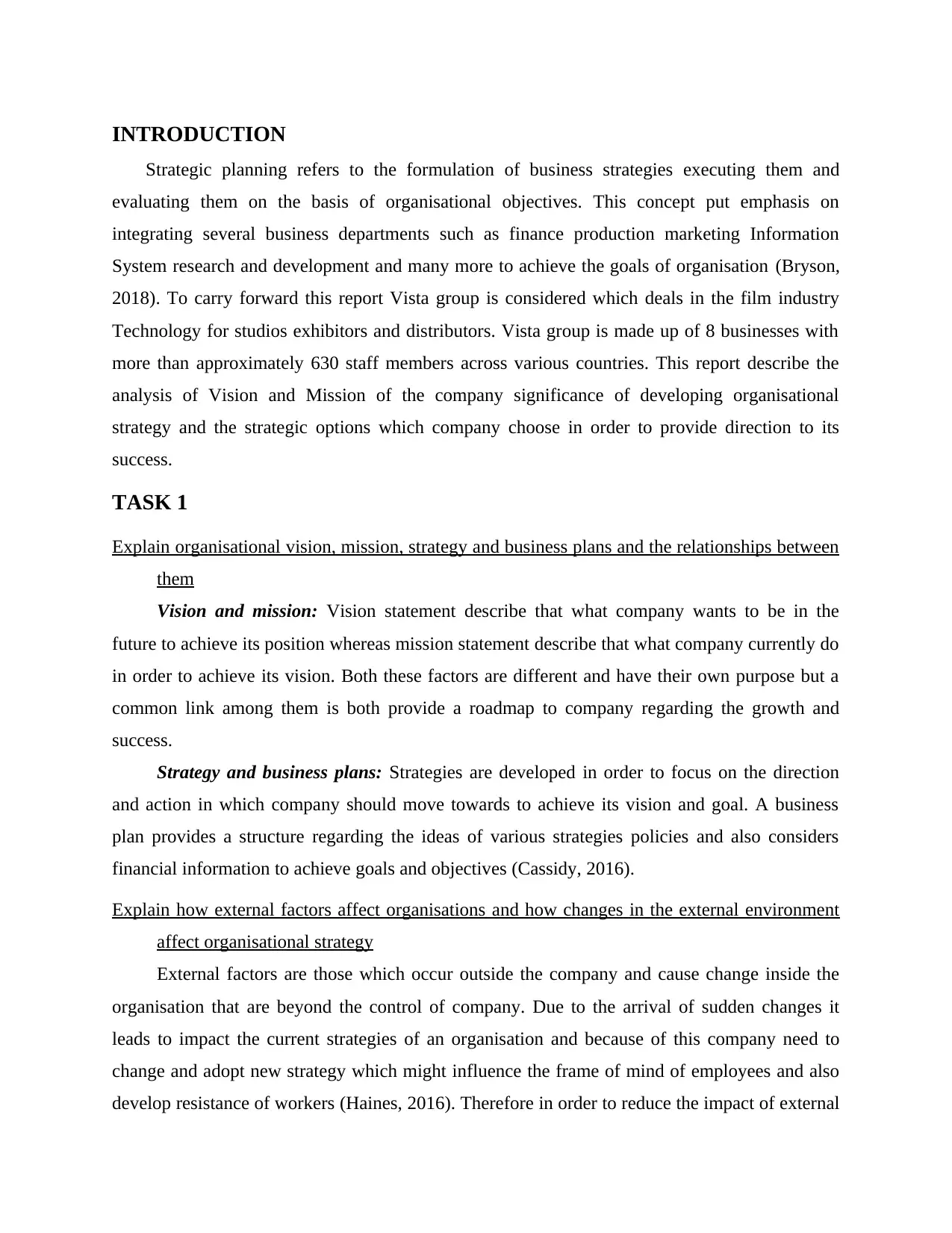
INTRODUCTION
Strategic planning refers to the formulation of business strategies executing them and
evaluating them on the basis of organisational objectives. This concept put emphasis on
integrating several business departments such as finance production marketing Information
System research and development and many more to achieve the goals of organisation (Bryson,
2018). To carry forward this report Vista group is considered which deals in the film industry
Technology for studios exhibitors and distributors. Vista group is made up of 8 businesses with
more than approximately 630 staff members across various countries. This report describe the
analysis of Vision and Mission of the company significance of developing organisational
strategy and the strategic options which company choose in order to provide direction to its
success.
TASK 1
Explain organisational vision, mission, strategy and business plans and the relationships between
them
Vision and mission: Vision statement describe that what company wants to be in the
future to achieve its position whereas mission statement describe that what company currently do
in order to achieve its vision. Both these factors are different and have their own purpose but a
common link among them is both provide a roadmap to company regarding the growth and
success.
Strategy and business plans: Strategies are developed in order to focus on the direction
and action in which company should move towards to achieve its vision and goal. A business
plan provides a structure regarding the ideas of various strategies policies and also considers
financial information to achieve goals and objectives (Cassidy, 2016).
Explain how external factors affect organisations and how changes in the external environment
affect organisational strategy
External factors are those which occur outside the company and cause change inside the
organisation that are beyond the control of company. Due to the arrival of sudden changes it
leads to impact the current strategies of an organisation and because of this company need to
change and adopt new strategy which might influence the frame of mind of employees and also
develop resistance of workers (Haines, 2016). Therefore in order to reduce the impact of external
Strategic planning refers to the formulation of business strategies executing them and
evaluating them on the basis of organisational objectives. This concept put emphasis on
integrating several business departments such as finance production marketing Information
System research and development and many more to achieve the goals of organisation (Bryson,
2018). To carry forward this report Vista group is considered which deals in the film industry
Technology for studios exhibitors and distributors. Vista group is made up of 8 businesses with
more than approximately 630 staff members across various countries. This report describe the
analysis of Vision and Mission of the company significance of developing organisational
strategy and the strategic options which company choose in order to provide direction to its
success.
TASK 1
Explain organisational vision, mission, strategy and business plans and the relationships between
them
Vision and mission: Vision statement describe that what company wants to be in the
future to achieve its position whereas mission statement describe that what company currently do
in order to achieve its vision. Both these factors are different and have their own purpose but a
common link among them is both provide a roadmap to company regarding the growth and
success.
Strategy and business plans: Strategies are developed in order to focus on the direction
and action in which company should move towards to achieve its vision and goal. A business
plan provides a structure regarding the ideas of various strategies policies and also considers
financial information to achieve goals and objectives (Cassidy, 2016).
Explain how external factors affect organisations and how changes in the external environment
affect organisational strategy
External factors are those which occur outside the company and cause change inside the
organisation that are beyond the control of company. Due to the arrival of sudden changes it
leads to impact the current strategies of an organisation and because of this company need to
change and adopt new strategy which might influence the frame of mind of employees and also
develop resistance of workers (Haines, 2016). Therefore in order to reduce the impact of external
Paraphrase This Document
Need a fresh take? Get an instant paraphrase of this document with our AI Paraphraser
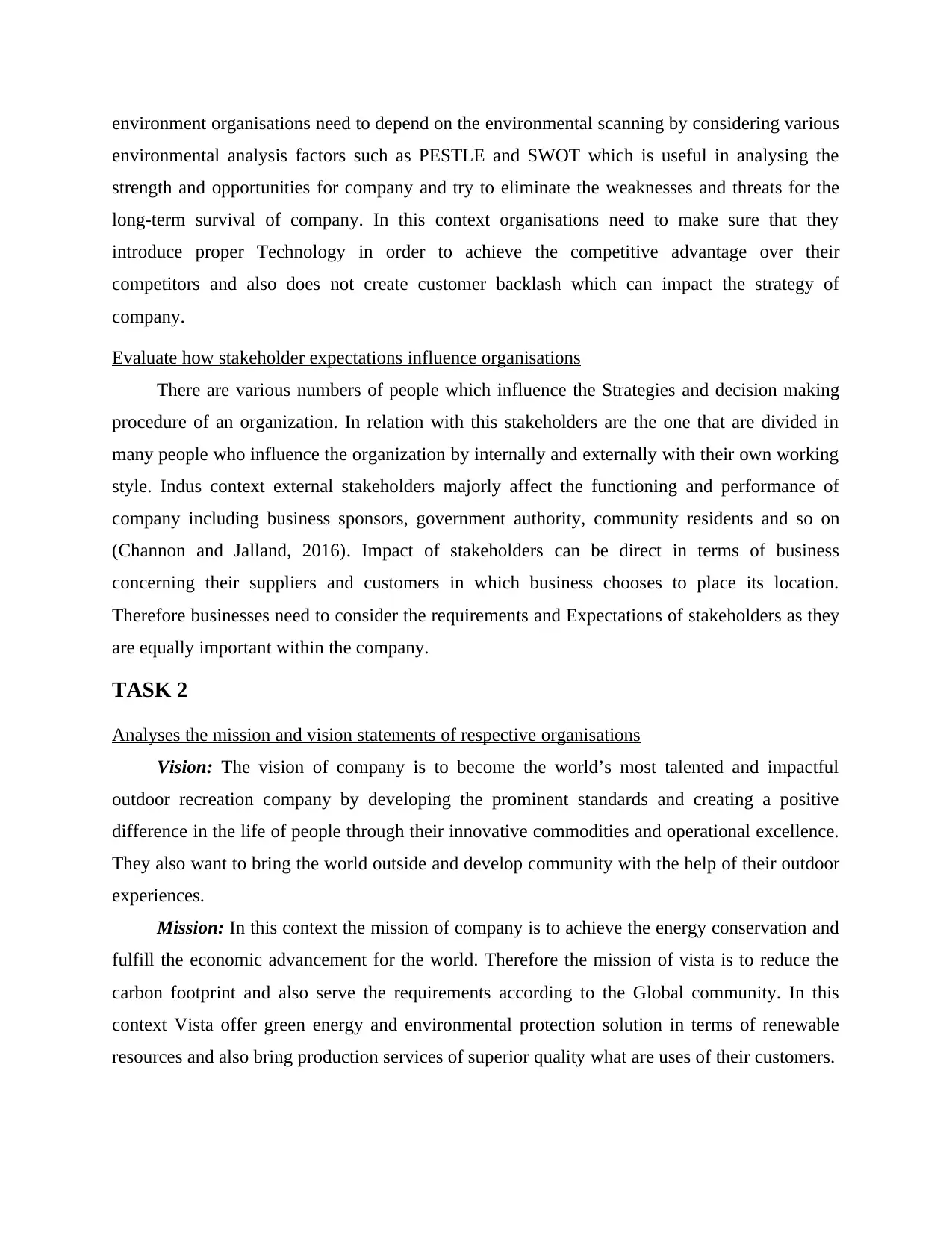
environment organisations need to depend on the environmental scanning by considering various
environmental analysis factors such as PESTLE and SWOT which is useful in analysing the
strength and opportunities for company and try to eliminate the weaknesses and threats for the
long-term survival of company. In this context organisations need to make sure that they
introduce proper Technology in order to achieve the competitive advantage over their
competitors and also does not create customer backlash which can impact the strategy of
company.
Evaluate how stakeholder expectations influence organisations
There are various numbers of people which influence the Strategies and decision making
procedure of an organization. In relation with this stakeholders are the one that are divided in
many people who influence the organization by internally and externally with their own working
style. Indus context external stakeholders majorly affect the functioning and performance of
company including business sponsors, government authority, community residents and so on
(Channon and Jalland, 2016). Impact of stakeholders can be direct in terms of business
concerning their suppliers and customers in which business chooses to place its location.
Therefore businesses need to consider the requirements and Expectations of stakeholders as they
are equally important within the company.
TASK 2
Analyses the mission and vision statements of respective organisations
Vision: The vision of company is to become the world’s most talented and impactful
outdoor recreation company by developing the prominent standards and creating a positive
difference in the life of people through their innovative commodities and operational excellence.
They also want to bring the world outside and develop community with the help of their outdoor
experiences.
Mission: In this context the mission of company is to achieve the energy conservation and
fulfill the economic advancement for the world. Therefore the mission of vista is to reduce the
carbon footprint and also serve the requirements according to the Global community. In this
context Vista offer green energy and environmental protection solution in terms of renewable
resources and also bring production services of superior quality what are uses of their customers.
environmental analysis factors such as PESTLE and SWOT which is useful in analysing the
strength and opportunities for company and try to eliminate the weaknesses and threats for the
long-term survival of company. In this context organisations need to make sure that they
introduce proper Technology in order to achieve the competitive advantage over their
competitors and also does not create customer backlash which can impact the strategy of
company.
Evaluate how stakeholder expectations influence organisations
There are various numbers of people which influence the Strategies and decision making
procedure of an organization. In relation with this stakeholders are the one that are divided in
many people who influence the organization by internally and externally with their own working
style. Indus context external stakeholders majorly affect the functioning and performance of
company including business sponsors, government authority, community residents and so on
(Channon and Jalland, 2016). Impact of stakeholders can be direct in terms of business
concerning their suppliers and customers in which business chooses to place its location.
Therefore businesses need to consider the requirements and Expectations of stakeholders as they
are equally important within the company.
TASK 2
Analyses the mission and vision statements of respective organisations
Vision: The vision of company is to become the world’s most talented and impactful
outdoor recreation company by developing the prominent standards and creating a positive
difference in the life of people through their innovative commodities and operational excellence.
They also want to bring the world outside and develop community with the help of their outdoor
experiences.
Mission: In this context the mission of company is to achieve the energy conservation and
fulfill the economic advancement for the world. Therefore the mission of vista is to reduce the
carbon footprint and also serve the requirements according to the Global community. In this
context Vista offer green energy and environmental protection solution in terms of renewable
resources and also bring production services of superior quality what are uses of their customers.
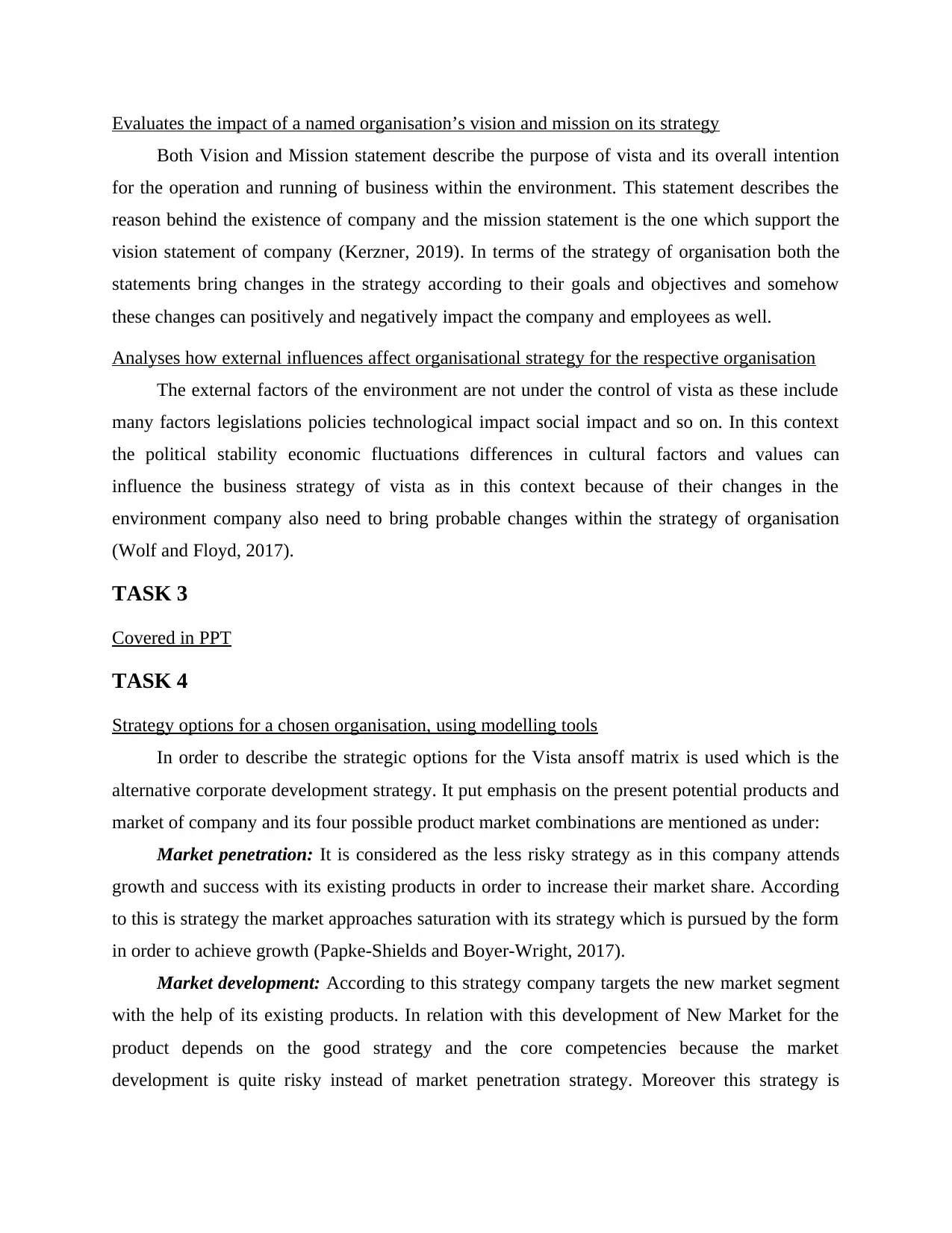
Evaluates the impact of a named organisation’s vision and mission on its strategy
Both Vision and Mission statement describe the purpose of vista and its overall intention
for the operation and running of business within the environment. This statement describes the
reason behind the existence of company and the mission statement is the one which support the
vision statement of company (Kerzner, 2019). In terms of the strategy of organisation both the
statements bring changes in the strategy according to their goals and objectives and somehow
these changes can positively and negatively impact the company and employees as well.
Analyses how external influences affect organisational strategy for the respective organisation
The external factors of the environment are not under the control of vista as these include
many factors legislations policies technological impact social impact and so on. In this context
the political stability economic fluctuations differences in cultural factors and values can
influence the business strategy of vista as in this context because of their changes in the
environment company also need to bring probable changes within the strategy of organisation
(Wolf and Floyd, 2017).
TASK 3
Covered in PPT
TASK 4
Strategy options for a chosen organisation, using modelling tools
In order to describe the strategic options for the Vista ansoff matrix is used which is the
alternative corporate development strategy. It put emphasis on the present potential products and
market of company and its four possible product market combinations are mentioned as under:
Market penetration: It is considered as the less risky strategy as in this company attends
growth and success with its existing products in order to increase their market share. According
to this is strategy the market approaches saturation with its strategy which is pursued by the form
in order to achieve growth (Papke-Shields and Boyer-Wright, 2017).
Market development: According to this strategy company targets the new market segment
with the help of its existing products. In relation with this development of New Market for the
product depends on the good strategy and the core competencies because the market
development is quite risky instead of market penetration strategy. Moreover this strategy is
Both Vision and Mission statement describe the purpose of vista and its overall intention
for the operation and running of business within the environment. This statement describes the
reason behind the existence of company and the mission statement is the one which support the
vision statement of company (Kerzner, 2019). In terms of the strategy of organisation both the
statements bring changes in the strategy according to their goals and objectives and somehow
these changes can positively and negatively impact the company and employees as well.
Analyses how external influences affect organisational strategy for the respective organisation
The external factors of the environment are not under the control of vista as these include
many factors legislations policies technological impact social impact and so on. In this context
the political stability economic fluctuations differences in cultural factors and values can
influence the business strategy of vista as in this context because of their changes in the
environment company also need to bring probable changes within the strategy of organisation
(Wolf and Floyd, 2017).
TASK 3
Covered in PPT
TASK 4
Strategy options for a chosen organisation, using modelling tools
In order to describe the strategic options for the Vista ansoff matrix is used which is the
alternative corporate development strategy. It put emphasis on the present potential products and
market of company and its four possible product market combinations are mentioned as under:
Market penetration: It is considered as the less risky strategy as in this company attends
growth and success with its existing products in order to increase their market share. According
to this is strategy the market approaches saturation with its strategy which is pursued by the form
in order to achieve growth (Papke-Shields and Boyer-Wright, 2017).
Market development: According to this strategy company targets the new market segment
with the help of its existing products. In relation with this development of New Market for the
product depends on the good strategy and the core competencies because the market
development is quite risky instead of market penetration strategy. Moreover this strategy is
⊘ This is a preview!⊘
Do you want full access?
Subscribe today to unlock all pages.

Trusted by 1+ million students worldwide
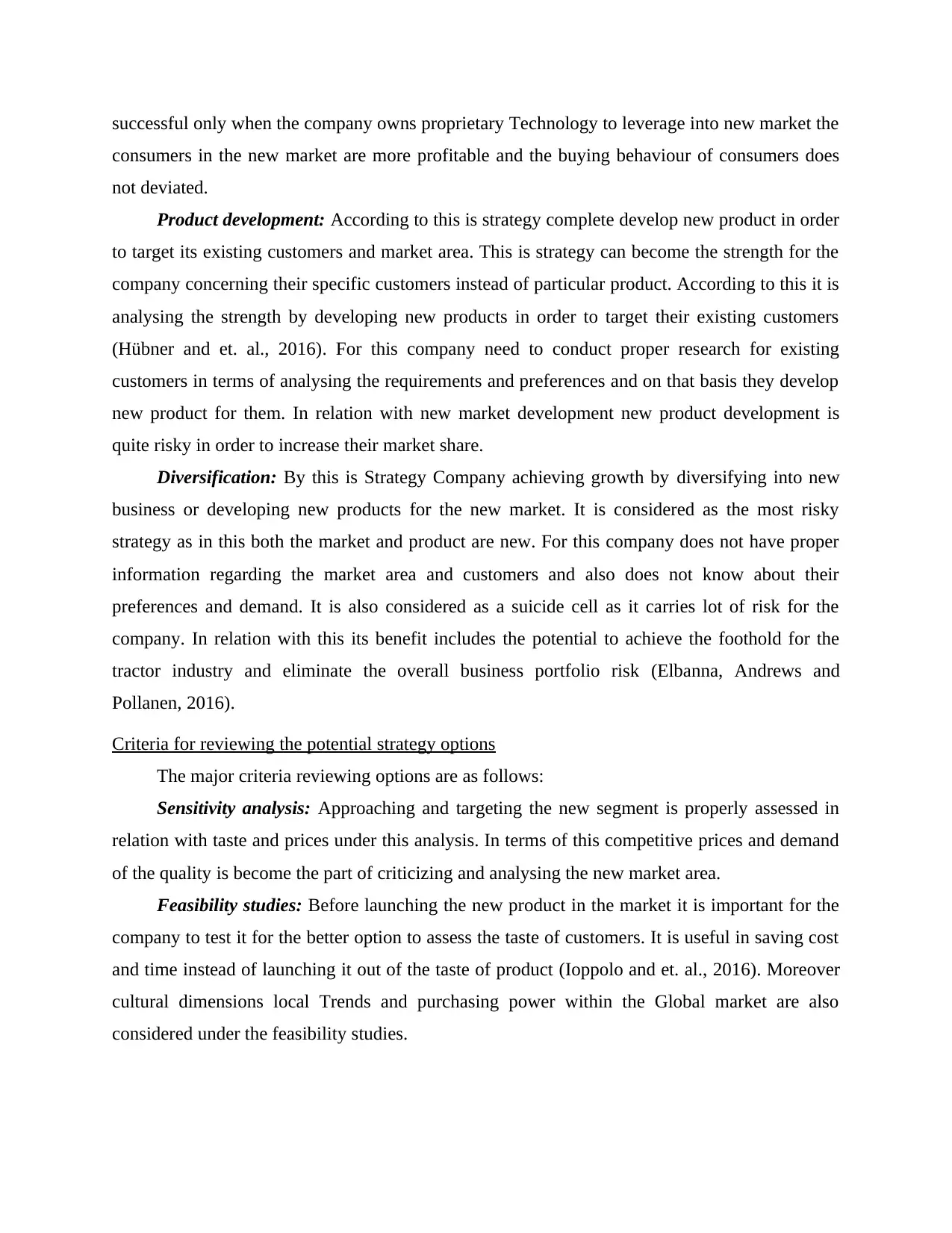
successful only when the company owns proprietary Technology to leverage into new market the
consumers in the new market are more profitable and the buying behaviour of consumers does
not deviated.
Product development: According to this is strategy complete develop new product in order
to target its existing customers and market area. This is strategy can become the strength for the
company concerning their specific customers instead of particular product. According to this it is
analysing the strength by developing new products in order to target their existing customers
(Hübner and et. al., 2016). For this company need to conduct proper research for existing
customers in terms of analysing the requirements and preferences and on that basis they develop
new product for them. In relation with new market development new product development is
quite risky in order to increase their market share.
Diversification: By this is Strategy Company achieving growth by diversifying into new
business or developing new products for the new market. It is considered as the most risky
strategy as in this both the market and product are new. For this company does not have proper
information regarding the market area and customers and also does not know about their
preferences and demand. It is also considered as a suicide cell as it carries lot of risk for the
company. In relation with this its benefit includes the potential to achieve the foothold for the
tractor industry and eliminate the overall business portfolio risk (Elbanna, Andrews and
Pollanen, 2016).
Criteria for reviewing the potential strategy options
The major criteria reviewing options are as follows:
Sensitivity analysis: Approaching and targeting the new segment is properly assessed in
relation with taste and prices under this analysis. In terms of this competitive prices and demand
of the quality is become the part of criticizing and analysing the new market area.
Feasibility studies: Before launching the new product in the market it is important for the
company to test it for the better option to assess the taste of customers. It is useful in saving cost
and time instead of launching it out of the taste of product (Ioppolo and et. al., 2016). Moreover
cultural dimensions local Trends and purchasing power within the Global market are also
considered under the feasibility studies.
consumers in the new market are more profitable and the buying behaviour of consumers does
not deviated.
Product development: According to this is strategy complete develop new product in order
to target its existing customers and market area. This is strategy can become the strength for the
company concerning their specific customers instead of particular product. According to this it is
analysing the strength by developing new products in order to target their existing customers
(Hübner and et. al., 2016). For this company need to conduct proper research for existing
customers in terms of analysing the requirements and preferences and on that basis they develop
new product for them. In relation with new market development new product development is
quite risky in order to increase their market share.
Diversification: By this is Strategy Company achieving growth by diversifying into new
business or developing new products for the new market. It is considered as the most risky
strategy as in this both the market and product are new. For this company does not have proper
information regarding the market area and customers and also does not know about their
preferences and demand. It is also considered as a suicide cell as it carries lot of risk for the
company. In relation with this its benefit includes the potential to achieve the foothold for the
tractor industry and eliminate the overall business portfolio risk (Elbanna, Andrews and
Pollanen, 2016).
Criteria for reviewing the potential strategy options
The major criteria reviewing options are as follows:
Sensitivity analysis: Approaching and targeting the new segment is properly assessed in
relation with taste and prices under this analysis. In terms of this competitive prices and demand
of the quality is become the part of criticizing and analysing the new market area.
Feasibility studies: Before launching the new product in the market it is important for the
company to test it for the better option to assess the taste of customers. It is useful in saving cost
and time instead of launching it out of the taste of product (Ioppolo and et. al., 2016). Moreover
cultural dimensions local Trends and purchasing power within the Global market are also
considered under the feasibility studies.
Paraphrase This Document
Need a fresh take? Get an instant paraphrase of this document with our AI Paraphraser
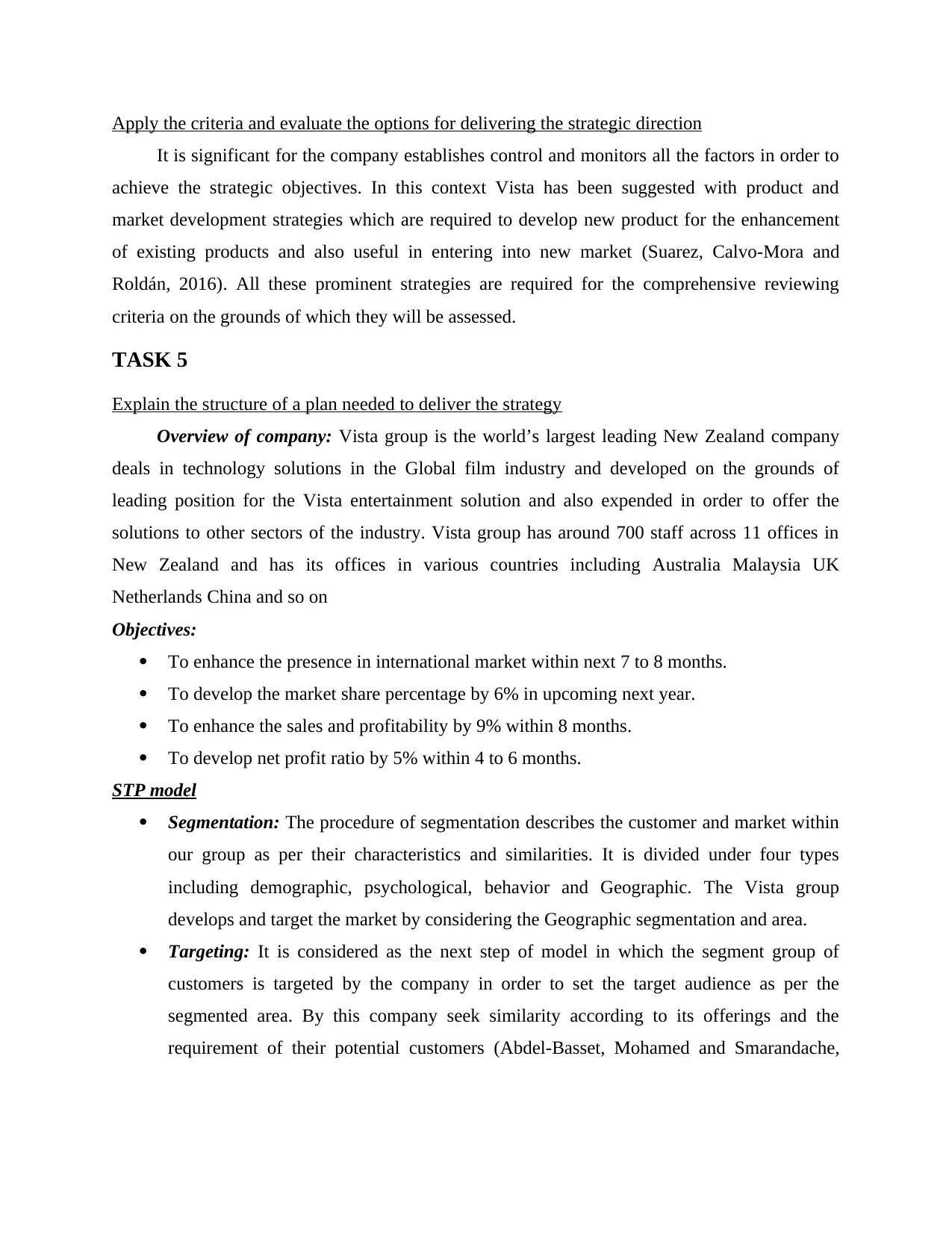
Apply the criteria and evaluate the options for delivering the strategic direction
It is significant for the company establishes control and monitors all the factors in order to
achieve the strategic objectives. In this context Vista has been suggested with product and
market development strategies which are required to develop new product for the enhancement
of existing products and also useful in entering into new market (Suarez, Calvo-Mora and
Roldán, 2016). All these prominent strategies are required for the comprehensive reviewing
criteria on the grounds of which they will be assessed.
TASK 5
Explain the structure of a plan needed to deliver the strategy
Overview of company: Vista group is the world’s largest leading New Zealand company
deals in technology solutions in the Global film industry and developed on the grounds of
leading position for the Vista entertainment solution and also expended in order to offer the
solutions to other sectors of the industry. Vista group has around 700 staff across 11 offices in
New Zealand and has its offices in various countries including Australia Malaysia UK
Netherlands China and so on
Objectives:
To enhance the presence in international market within next 7 to 8 months.
To develop the market share percentage by 6% in upcoming next year.
To enhance the sales and profitability by 9% within 8 months.
To develop net profit ratio by 5% within 4 to 6 months.
STP model
Segmentation: The procedure of segmentation describes the customer and market within
our group as per their characteristics and similarities. It is divided under four types
including demographic, psychological, behavior and Geographic. The Vista group
develops and target the market by considering the Geographic segmentation and area.
Targeting: It is considered as the next step of model in which the segment group of
customers is targeted by the company in order to set the target audience as per the
segmented area. By this company seek similarity according to its offerings and the
requirement of their potential customers (Abdel-Basset, Mohamed and Smarandache,
It is significant for the company establishes control and monitors all the factors in order to
achieve the strategic objectives. In this context Vista has been suggested with product and
market development strategies which are required to develop new product for the enhancement
of existing products and also useful in entering into new market (Suarez, Calvo-Mora and
Roldán, 2016). All these prominent strategies are required for the comprehensive reviewing
criteria on the grounds of which they will be assessed.
TASK 5
Explain the structure of a plan needed to deliver the strategy
Overview of company: Vista group is the world’s largest leading New Zealand company
deals in technology solutions in the Global film industry and developed on the grounds of
leading position for the Vista entertainment solution and also expended in order to offer the
solutions to other sectors of the industry. Vista group has around 700 staff across 11 offices in
New Zealand and has its offices in various countries including Australia Malaysia UK
Netherlands China and so on
Objectives:
To enhance the presence in international market within next 7 to 8 months.
To develop the market share percentage by 6% in upcoming next year.
To enhance the sales and profitability by 9% within 8 months.
To develop net profit ratio by 5% within 4 to 6 months.
STP model
Segmentation: The procedure of segmentation describes the customer and market within
our group as per their characteristics and similarities. It is divided under four types
including demographic, psychological, behavior and Geographic. The Vista group
develops and target the market by considering the Geographic segmentation and area.
Targeting: It is considered as the next step of model in which the segment group of
customers is targeted by the company in order to set the target audience as per the
segmented area. By this company seek similarity according to its offerings and the
requirement of their potential customers (Abdel-Basset, Mohamed and Smarandache,
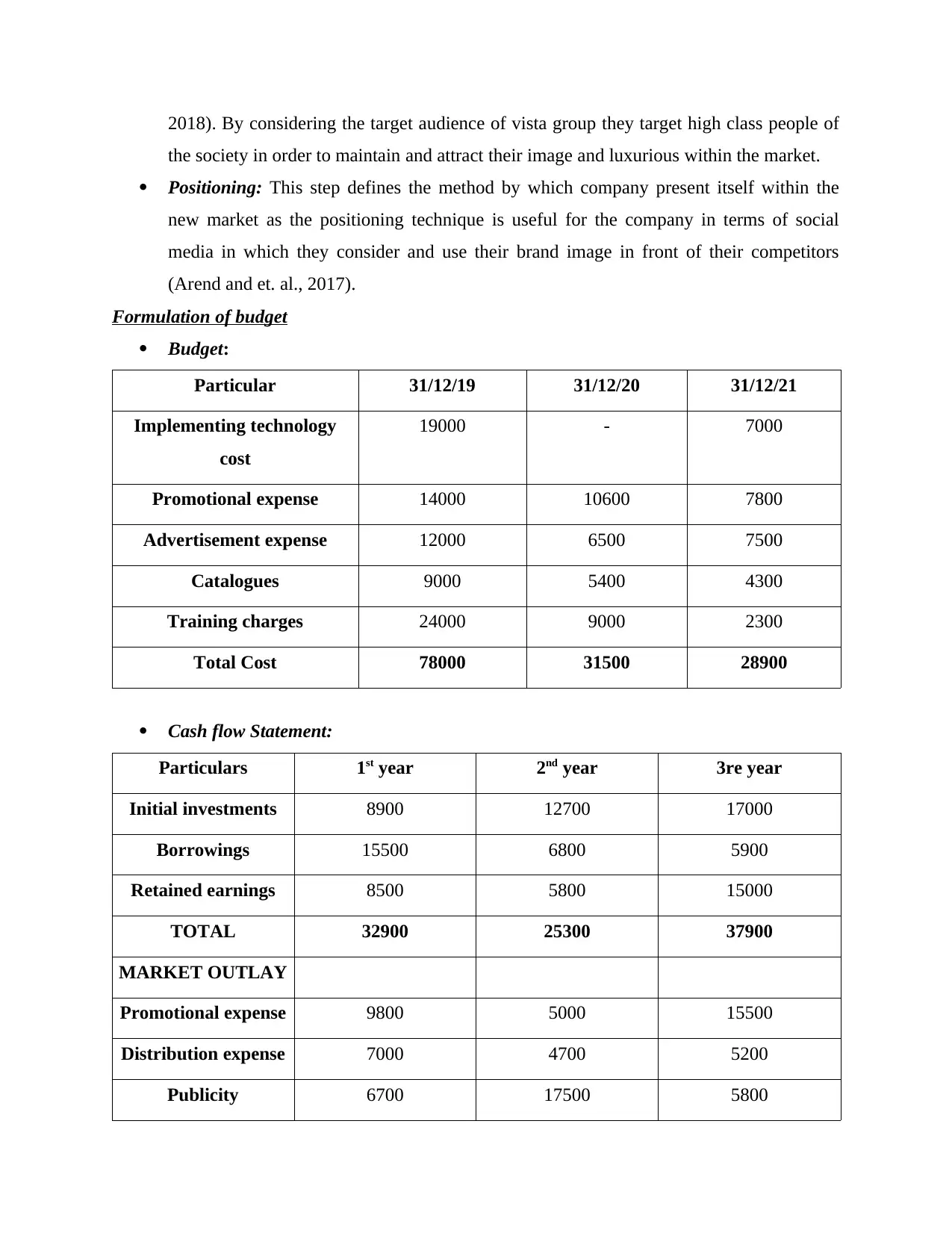
2018). By considering the target audience of vista group they target high class people of
the society in order to maintain and attract their image and luxurious within the market.
Positioning: This step defines the method by which company present itself within the
new market as the positioning technique is useful for the company in terms of social
media in which they consider and use their brand image in front of their competitors
(Arend and et. al., 2017).
Formulation of budget
Budget:
Particular 31/12/19 31/12/20 31/12/21
Implementing technology
cost
19000 - 7000
Promotional expense 14000 10600 7800
Advertisement expense 12000 6500 7500
Catalogues 9000 5400 4300
Training charges 24000 9000 2300
Total Cost 78000 31500 28900
Cash flow Statement:
Particulars 1st year 2nd year 3re year
Initial investments 8900 12700 17000
Borrowings 15500 6800 5900
Retained earnings 8500 5800 15000
TOTAL 32900 25300 37900
MARKET OUTLAY
Promotional expense 9800 5000 15500
Distribution expense 7000 4700 5200
Publicity 6700 17500 5800
the society in order to maintain and attract their image and luxurious within the market.
Positioning: This step defines the method by which company present itself within the
new market as the positioning technique is useful for the company in terms of social
media in which they consider and use their brand image in front of their competitors
(Arend and et. al., 2017).
Formulation of budget
Budget:
Particular 31/12/19 31/12/20 31/12/21
Implementing technology
cost
19000 - 7000
Promotional expense 14000 10600 7800
Advertisement expense 12000 6500 7500
Catalogues 9000 5400 4300
Training charges 24000 9000 2300
Total Cost 78000 31500 28900
Cash flow Statement:
Particulars 1st year 2nd year 3re year
Initial investments 8900 12700 17000
Borrowings 15500 6800 5900
Retained earnings 8500 5800 15000
TOTAL 32900 25300 37900
MARKET OUTLAY
Promotional expense 9800 5000 15500
Distribution expense 7000 4700 5200
Publicity 6700 17500 5800
⊘ This is a preview!⊘
Do you want full access?
Subscribe today to unlock all pages.

Trusted by 1+ million students worldwide
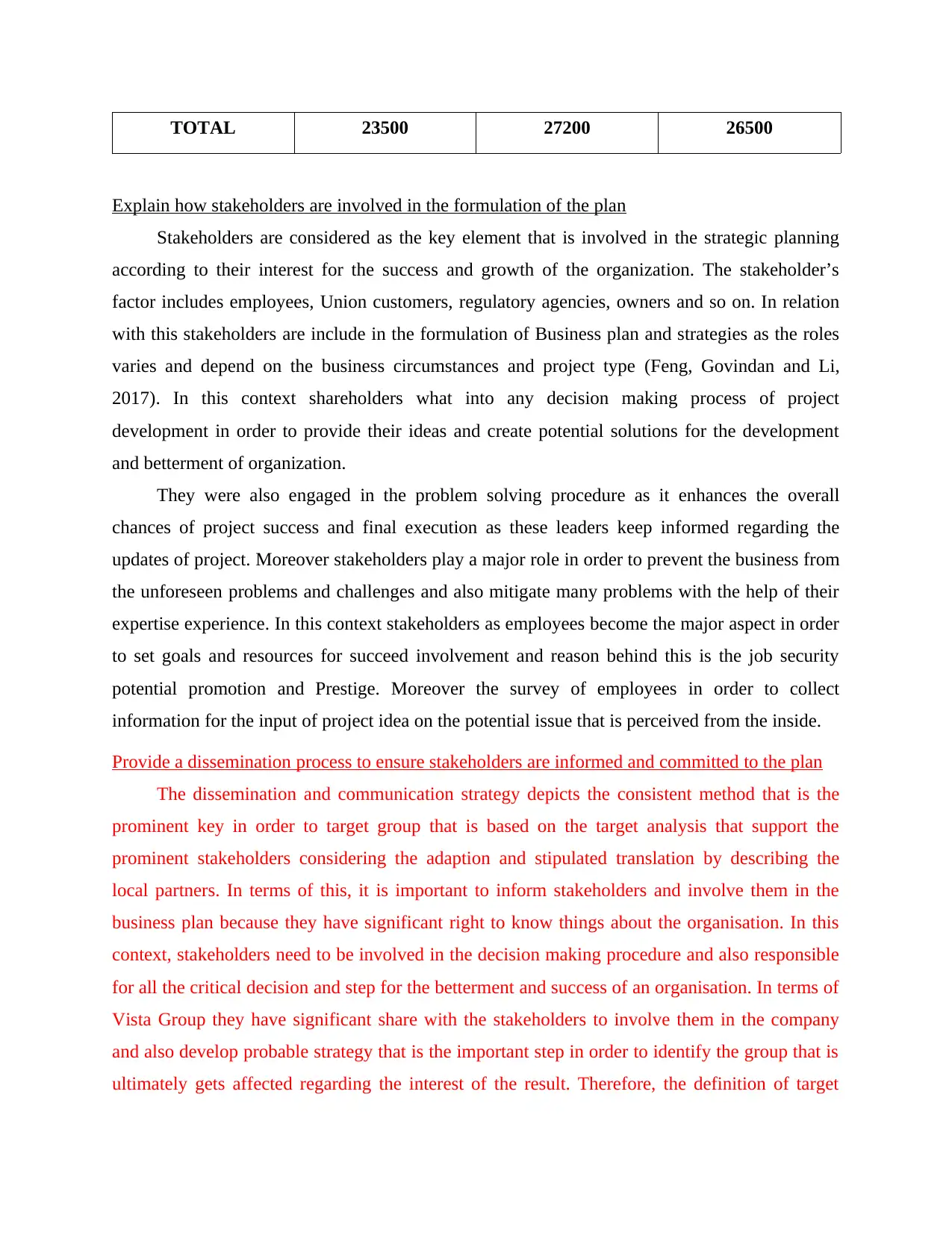
TOTAL 23500 27200 26500
Explain how stakeholders are involved in the formulation of the plan
Stakeholders are considered as the key element that is involved in the strategic planning
according to their interest for the success and growth of the organization. The stakeholder’s
factor includes employees, Union customers, regulatory agencies, owners and so on. In relation
with this stakeholders are include in the formulation of Business plan and strategies as the roles
varies and depend on the business circumstances and project type (Feng, Govindan and Li,
2017). In this context shareholders what into any decision making process of project
development in order to provide their ideas and create potential solutions for the development
and betterment of organization.
They were also engaged in the problem solving procedure as it enhances the overall
chances of project success and final execution as these leaders keep informed regarding the
updates of project. Moreover stakeholders play a major role in order to prevent the business from
the unforeseen problems and challenges and also mitigate many problems with the help of their
expertise experience. In this context stakeholders as employees become the major aspect in order
to set goals and resources for succeed involvement and reason behind this is the job security
potential promotion and Prestige. Moreover the survey of employees in order to collect
information for the input of project idea on the potential issue that is perceived from the inside.
Provide a dissemination process to ensure stakeholders are informed and committed to the plan
The dissemination and communication strategy depicts the consistent method that is the
prominent key in order to target group that is based on the target analysis that support the
prominent stakeholders considering the adaption and stipulated translation by describing the
local partners. In terms of this, it is important to inform stakeholders and involve them in the
business plan because they have significant right to know things about the organisation. In this
context, stakeholders need to be involved in the decision making procedure and also responsible
for all the critical decision and step for the betterment and success of an organisation. In terms of
Vista Group they have significant share with the stakeholders to involve them in the company
and also develop probable strategy that is the important step in order to identify the group that is
ultimately gets affected regarding the interest of the result. Therefore, the definition of target
Explain how stakeholders are involved in the formulation of the plan
Stakeholders are considered as the key element that is involved in the strategic planning
according to their interest for the success and growth of the organization. The stakeholder’s
factor includes employees, Union customers, regulatory agencies, owners and so on. In relation
with this stakeholders are include in the formulation of Business plan and strategies as the roles
varies and depend on the business circumstances and project type (Feng, Govindan and Li,
2017). In this context shareholders what into any decision making process of project
development in order to provide their ideas and create potential solutions for the development
and betterment of organization.
They were also engaged in the problem solving procedure as it enhances the overall
chances of project success and final execution as these leaders keep informed regarding the
updates of project. Moreover stakeholders play a major role in order to prevent the business from
the unforeseen problems and challenges and also mitigate many problems with the help of their
expertise experience. In this context stakeholders as employees become the major aspect in order
to set goals and resources for succeed involvement and reason behind this is the job security
potential promotion and Prestige. Moreover the survey of employees in order to collect
information for the input of project idea on the potential issue that is perceived from the inside.
Provide a dissemination process to ensure stakeholders are informed and committed to the plan
The dissemination and communication strategy depicts the consistent method that is the
prominent key in order to target group that is based on the target analysis that support the
prominent stakeholders considering the adaption and stipulated translation by describing the
local partners. In terms of this, it is important to inform stakeholders and involve them in the
business plan because they have significant right to know things about the organisation. In this
context, stakeholders need to be involved in the decision making procedure and also responsible
for all the critical decision and step for the betterment and success of an organisation. In terms of
Vista Group they have significant share with the stakeholders to involve them in the company
and also develop probable strategy that is the important step in order to identify the group that is
ultimately gets affected regarding the interest of the result. Therefore, the definition of target
Paraphrase This Document
Need a fresh take? Get an instant paraphrase of this document with our AI Paraphraser
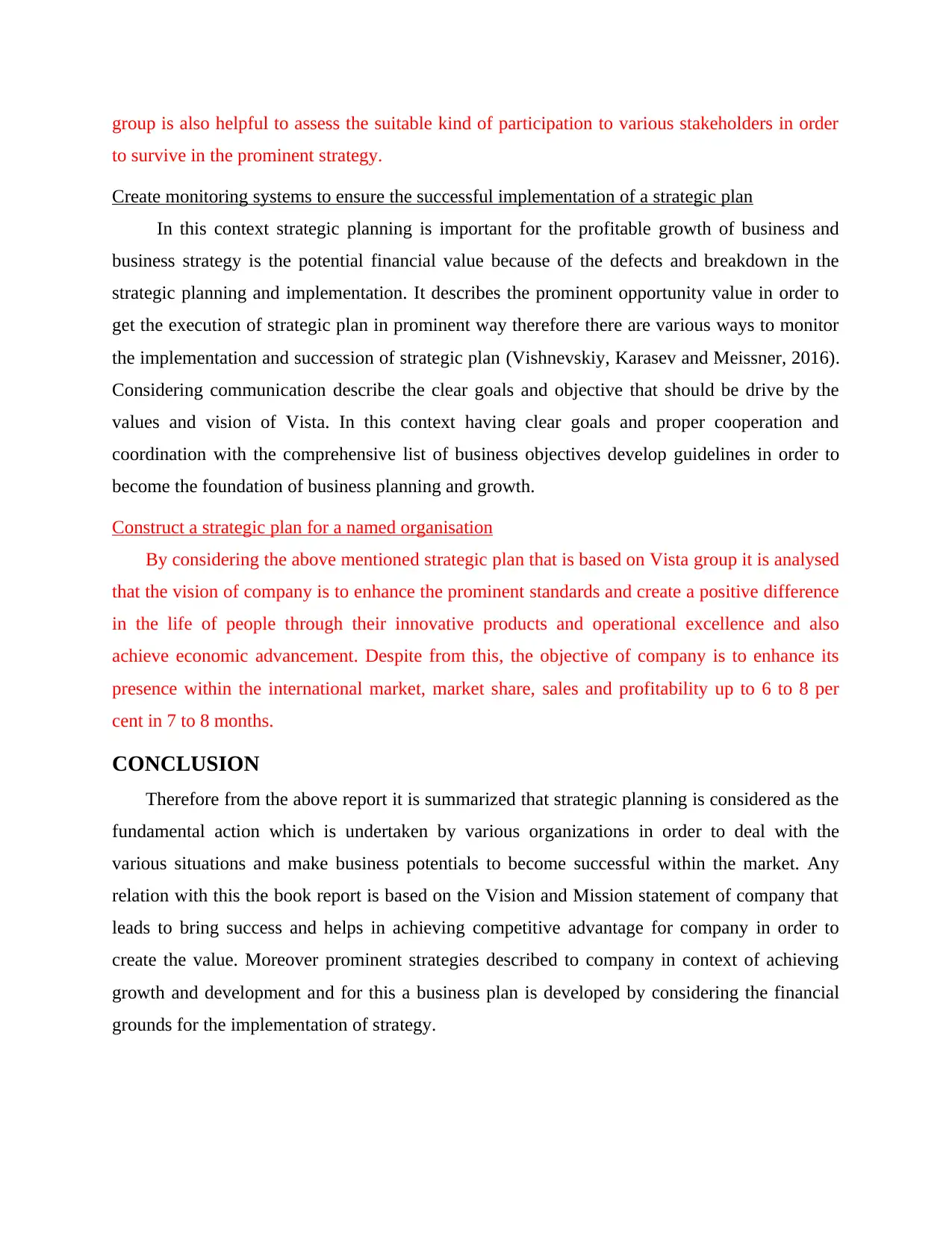
group is also helpful to assess the suitable kind of participation to various stakeholders in order
to survive in the prominent strategy.
Create monitoring systems to ensure the successful implementation of a strategic plan
In this context strategic planning is important for the profitable growth of business and
business strategy is the potential financial value because of the defects and breakdown in the
strategic planning and implementation. It describes the prominent opportunity value in order to
get the execution of strategic plan in prominent way therefore there are various ways to monitor
the implementation and succession of strategic plan (Vishnevskiy, Karasev and Meissner, 2016).
Considering communication describe the clear goals and objective that should be drive by the
values and vision of Vista. In this context having clear goals and proper cooperation and
coordination with the comprehensive list of business objectives develop guidelines in order to
become the foundation of business planning and growth.
Construct a strategic plan for a named organisation
By considering the above mentioned strategic plan that is based on Vista group it is analysed
that the vision of company is to enhance the prominent standards and create a positive difference
in the life of people through their innovative products and operational excellence and also
achieve economic advancement. Despite from this, the objective of company is to enhance its
presence within the international market, market share, sales and profitability up to 6 to 8 per
cent in 7 to 8 months.
CONCLUSION
Therefore from the above report it is summarized that strategic planning is considered as the
fundamental action which is undertaken by various organizations in order to deal with the
various situations and make business potentials to become successful within the market. Any
relation with this the book report is based on the Vision and Mission statement of company that
leads to bring success and helps in achieving competitive advantage for company in order to
create the value. Moreover prominent strategies described to company in context of achieving
growth and development and for this a business plan is developed by considering the financial
grounds for the implementation of strategy.
to survive in the prominent strategy.
Create monitoring systems to ensure the successful implementation of a strategic plan
In this context strategic planning is important for the profitable growth of business and
business strategy is the potential financial value because of the defects and breakdown in the
strategic planning and implementation. It describes the prominent opportunity value in order to
get the execution of strategic plan in prominent way therefore there are various ways to monitor
the implementation and succession of strategic plan (Vishnevskiy, Karasev and Meissner, 2016).
Considering communication describe the clear goals and objective that should be drive by the
values and vision of Vista. In this context having clear goals and proper cooperation and
coordination with the comprehensive list of business objectives develop guidelines in order to
become the foundation of business planning and growth.
Construct a strategic plan for a named organisation
By considering the above mentioned strategic plan that is based on Vista group it is analysed
that the vision of company is to enhance the prominent standards and create a positive difference
in the life of people through their innovative products and operational excellence and also
achieve economic advancement. Despite from this, the objective of company is to enhance its
presence within the international market, market share, sales and profitability up to 6 to 8 per
cent in 7 to 8 months.
CONCLUSION
Therefore from the above report it is summarized that strategic planning is considered as the
fundamental action which is undertaken by various organizations in order to deal with the
various situations and make business potentials to become successful within the market. Any
relation with this the book report is based on the Vision and Mission statement of company that
leads to bring success and helps in achieving competitive advantage for company in order to
create the value. Moreover prominent strategies described to company in context of achieving
growth and development and for this a business plan is developed by considering the financial
grounds for the implementation of strategy.
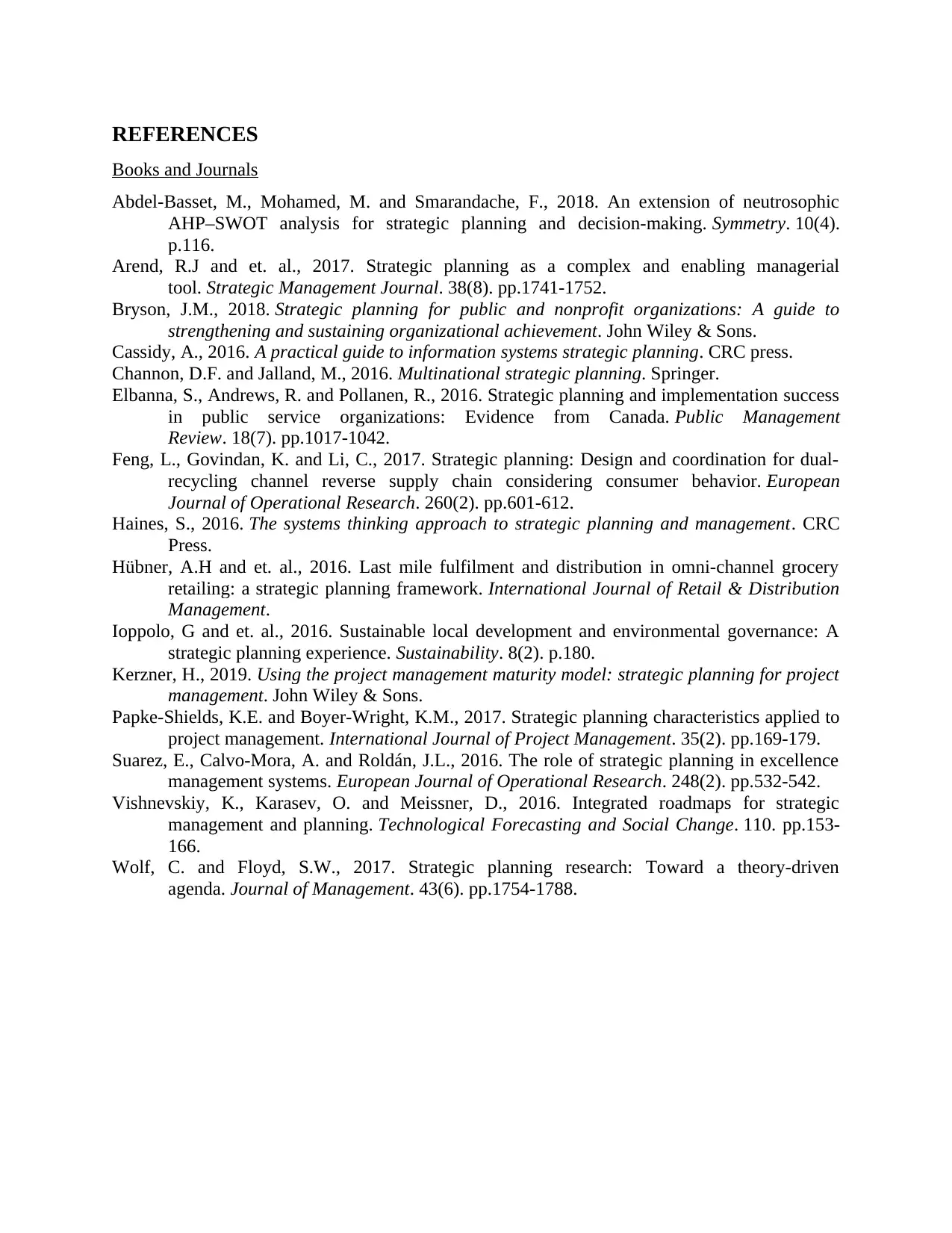
REFERENCES
Books and Journals
Abdel-Basset, M., Mohamed, M. and Smarandache, F., 2018. An extension of neutrosophic
AHP–SWOT analysis for strategic planning and decision-making. Symmetry. 10(4).
p.116.
Arend, R.J and et. al., 2017. Strategic planning as a complex and enabling managerial
tool. Strategic Management Journal. 38(8). pp.1741-1752.
Bryson, J.M., 2018. Strategic planning for public and nonprofit organizations: A guide to
strengthening and sustaining organizational achievement. John Wiley & Sons.
Cassidy, A., 2016. A practical guide to information systems strategic planning. CRC press.
Channon, D.F. and Jalland, M., 2016. Multinational strategic planning. Springer.
Elbanna, S., Andrews, R. and Pollanen, R., 2016. Strategic planning and implementation success
in public service organizations: Evidence from Canada. Public Management
Review. 18(7). pp.1017-1042.
Feng, L., Govindan, K. and Li, C., 2017. Strategic planning: Design and coordination for dual-
recycling channel reverse supply chain considering consumer behavior. European
Journal of Operational Research. 260(2). pp.601-612.
Haines, S., 2016. The systems thinking approach to strategic planning and management. CRC
Press.
Hübner, A.H and et. al., 2016. Last mile fulfilment and distribution in omni-channel grocery
retailing: a strategic planning framework. International Journal of Retail & Distribution
Management.
Ioppolo, G and et. al., 2016. Sustainable local development and environmental governance: A
strategic planning experience. Sustainability. 8(2). p.180.
Kerzner, H., 2019. Using the project management maturity model: strategic planning for project
management. John Wiley & Sons.
Papke-Shields, K.E. and Boyer-Wright, K.M., 2017. Strategic planning characteristics applied to
project management. International Journal of Project Management. 35(2). pp.169-179.
Suarez, E., Calvo-Mora, A. and Roldán, J.L., 2016. The role of strategic planning in excellence
management systems. European Journal of Operational Research. 248(2). pp.532-542.
Vishnevskiy, K., Karasev, O. and Meissner, D., 2016. Integrated roadmaps for strategic
management and planning. Technological Forecasting and Social Change. 110. pp.153-
166.
Wolf, C. and Floyd, S.W., 2017. Strategic planning research: Toward a theory-driven
agenda. Journal of Management. 43(6). pp.1754-1788.
Books and Journals
Abdel-Basset, M., Mohamed, M. and Smarandache, F., 2018. An extension of neutrosophic
AHP–SWOT analysis for strategic planning and decision-making. Symmetry. 10(4).
p.116.
Arend, R.J and et. al., 2017. Strategic planning as a complex and enabling managerial
tool. Strategic Management Journal. 38(8). pp.1741-1752.
Bryson, J.M., 2018. Strategic planning for public and nonprofit organizations: A guide to
strengthening and sustaining organizational achievement. John Wiley & Sons.
Cassidy, A., 2016. A practical guide to information systems strategic planning. CRC press.
Channon, D.F. and Jalland, M., 2016. Multinational strategic planning. Springer.
Elbanna, S., Andrews, R. and Pollanen, R., 2016. Strategic planning and implementation success
in public service organizations: Evidence from Canada. Public Management
Review. 18(7). pp.1017-1042.
Feng, L., Govindan, K. and Li, C., 2017. Strategic planning: Design and coordination for dual-
recycling channel reverse supply chain considering consumer behavior. European
Journal of Operational Research. 260(2). pp.601-612.
Haines, S., 2016. The systems thinking approach to strategic planning and management. CRC
Press.
Hübner, A.H and et. al., 2016. Last mile fulfilment and distribution in omni-channel grocery
retailing: a strategic planning framework. International Journal of Retail & Distribution
Management.
Ioppolo, G and et. al., 2016. Sustainable local development and environmental governance: A
strategic planning experience. Sustainability. 8(2). p.180.
Kerzner, H., 2019. Using the project management maturity model: strategic planning for project
management. John Wiley & Sons.
Papke-Shields, K.E. and Boyer-Wright, K.M., 2017. Strategic planning characteristics applied to
project management. International Journal of Project Management. 35(2). pp.169-179.
Suarez, E., Calvo-Mora, A. and Roldán, J.L., 2016. The role of strategic planning in excellence
management systems. European Journal of Operational Research. 248(2). pp.532-542.
Vishnevskiy, K., Karasev, O. and Meissner, D., 2016. Integrated roadmaps for strategic
management and planning. Technological Forecasting and Social Change. 110. pp.153-
166.
Wolf, C. and Floyd, S.W., 2017. Strategic planning research: Toward a theory-driven
agenda. Journal of Management. 43(6). pp.1754-1788.
⊘ This is a preview!⊘
Do you want full access?
Subscribe today to unlock all pages.

Trusted by 1+ million students worldwide
1 out of 12
Related Documents
Your All-in-One AI-Powered Toolkit for Academic Success.
+13062052269
info@desklib.com
Available 24*7 on WhatsApp / Email
![[object Object]](/_next/static/media/star-bottom.7253800d.svg)
Unlock your academic potential
Copyright © 2020–2025 A2Z Services. All Rights Reserved. Developed and managed by ZUCOL.




